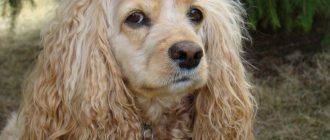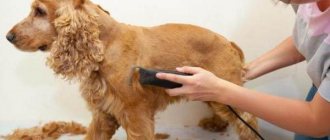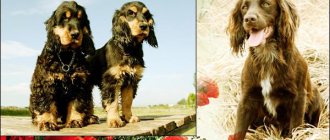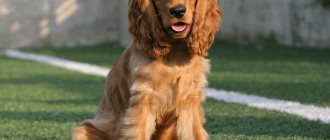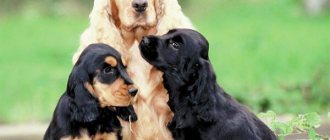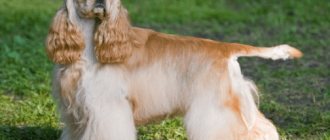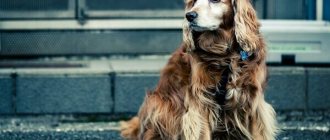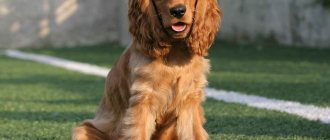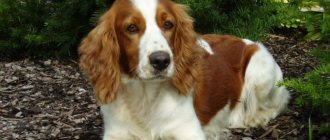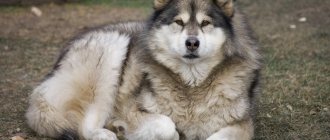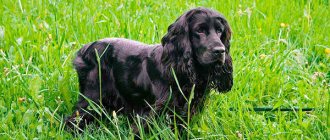Cockers are a wonderful breed of dog: active, cheerful and love to eat, and they will make anyone smile.
The English Cocker Spaniel, despite its roots as a hunter, is considered an excellent friend for the whole family. His cute face and dignified behavior are proof of this.
Those who want to have a pet often pay attention to this breed.
History of the English Cocker Spaniel breed
English Cocker Spaniel
Despite the fact that the official history of the breed begins in the 19th century, residents of Great Britain became acquainted with its representatives much earlier. Well, to be more precise, all English cockers are descended from spaniels that have lived on the shores of Foggy Albion since time immemorial. Scientists have ranked the spaniels themselves among the relatives of the ancient ash dogs that accompanied man during the Bronze Age. Although some experts still consider the Mediterranean coast to be the homeland of animals, citing as evidence the Old French name of the breed “espaigneul”, that is, literally, a Spanish dog. However, be that as it may, the ancestors of cockers in England took root and even began to participate in crossbreeding experiments, which led to the stratification of this dog tribe.
By nature, all spaniels are good pursuers of feathered game. However, in the 19th century, the hunting qualities of dogs underwent a large-scale “upgrade” on the part of breeders, as a result of which the spaniel genus split into two distinct families. Large individuals, the so-called field spaniels, whose weight exceeded 11 kg, began to compete with their lighter counterparts - the ancestors of today's cockers. By the way, the British Esquires themselves preferred to go hunting for game birds with more massive dogs, leaving the cocker spaniels to hunt woodcocks, which gave the animals a start in life.
1893 is the year of official recognition of the English Cocker Spaniel breed and its final separation from the Field Spaniel clan. At first, the weight of dogs was strictly regulated by the standard, which somewhat hampered their breeding. But when restrictions were lifted, British nurseries were able to catch up in just a few years. The breed was imported to Russia several times, but it did not arouse great enthusiasm among both breeders and ordinary people. As a result, the full-fledged breeding of English cocker spaniels in our country began very late, approximately in the mid-70s.
An interesting fact: British breeders claim that the word “cocker” in the name of the breed is a shortened form of the English “woodcock”.
Interesting Facts
- The name "cocker" comes from the English word "woodcock" - forest bird (woodcock). It was this feathered game that was hunted by the first representatives of the breed.
- These dogs are often used by law enforcement agencies to search for drugs and other illegal substances.
- The writer Mikhail Prishvin had 4 spaniels.
- The children's book “Tomka” by Evgeny Charushin is dedicated to a spaniel puppy.
Appearance of an English Cocker Spaniel
English Cocker Spaniel Puppy
Although the English Cocker is inferior in appearance to his glamorous American “cousin”, he does not look like a poor relative compared to him. In general, the “English” are larger than the “American” (the average weight of an adult male is 13-14.5 kg) and are a centimeter or two higher at the withers. At the same time, they have a completely harmonious physique. The dog looks especially graceful in motion, and it doesn’t matter at all whether it’s rushing across the field after prey or just trying to catch a Frisbee disc.
Head
The English Cocker Spaniel has a normal, not wide and moderately short skull. The muzzle is proportional, square, with a raised stop.
Jaws
Massive, with a classic type of bite (“scissors”).
Nose
The exceptional sense of smell of English Cocker Spaniels is ensured by their fleshy nose with wide, open nostrils.
Eyes
Large, without noticeable bulge, dark brown or brown in color. Dogs with chocolate coats typically have nutty irises.
Ears
Long, oval, low set. Covered with soft, silky hair. Ear type: hanging.
Neck
The neck of a correct English Cocker should not be very long, strong, muscular and without folds.
Muzzle of an English Cocker Spaniel
Frame
Purebred representatives of the breed have a strong body of compact size. The back of the English Cocker Spaniel is straight, without a hint of sagging. The croup is massive, but short. The chest is moderately deep and spacious, but without noticeable convexity or barrel-shape.
Limbs
Great guys
The ideal option is to have strong, straight and not overly elongated legs. The shoulders and knees of this breed are well bent, which makes the dog's movements freer, and the reach of the front limbs greater. The elastic push of the English Cocker is provided by good angles of the articulations of the metatarsus and hock joint. The animal's paws are rounded, with toes tightly adjacent to each other and elastic pads.
Tail
The tail of the English Cocker Spaniel breed is traditionally docked. But since this procedure is prohibited in a number of countries, at exhibitions there are individuals who have never been subjected to it. The natural length of a dog's tail is to the hocks, the set is noticeably lower than the level of the back, the shape is thick at the base and tapering as it approaches the tip. The docked tail should not be too short, which would prevent the “Englishman” from clearly expressing his own emotions and, as a result, significantly worsen his hunting performance.
Wool
Fitted, very soft, not frizzy or wavy. On the front and hind legs, belly and groin area the hair is more abundant, with a slight wave. There are fringes.
Color
Black and white English Cocker Spaniel puppy
The FCI standard grants English Cocker Spaniels the right to solid, spotted, tricolor and speckled color types.
Solid (one color):
- golden;
- black;
- red;
- chocolate;
- liver with scorch marks;
- black with tan.
Spotted:
- fawn with white;
- red and white;
- liver with white;
- black and white.
Tricolor:
- black and white with tan;
- liver white with tan.
Speckled:
- fawn roan;
- red roan;
- blue roan;
- hepatic roan;
- liver roan with scorch marks;
- blue roan with tan marks.
Defects and disqualifying defects
There are a lot of reasons for lowering the rating of show cocker spaniels, from curly hair to a short neck. Disadvantages that exclude the possibility of an animal entering the “Champions League” also include a deformed or hunchbacked back, cow-like limbs and white “patches” on the chest and throat of individuals with a monocolor.
An English cocker can withdraw from the competition at the selection stage only if he is diagnosed with malocclusion, pink lobes, depigmented lips, yellowish irises and cryptorchidism. Aggressive individuals and dogs that amble have nothing to do at exhibitions either.
Papillon
- Height: from 20 to 28 cm
- Weight: from 3.2 to 4.5 kg
- Life expectancy: 13 to 15 years
- Temperament: smart, mischievous, friendly, energetic, attentive
When Josh Billings said, “A dog is the only creature on the planet that loves you more than itself,” he must have been talking about the Papillon. Papillons, also known as continental toy spaniels, will be your loving four-legged companions until the very end. But these are not the dogs you should get if you are away from home for a long time.
These dogs are naturally blessed with adorable ears with fringed edges, giving them the name "Papillon", which means "butterfly" in French. And it is right! These dogs are bright, outgoing and energetic, making them ideal companions.
Papillons are overly friendly and will get along well with other pets. But don't let their small size fool you. Their watchful nature, typical of guard dogs, will easily drive away all the small rodents from your garden. Although Papillons are not hunting dogs, they do have a "spaniel instinct" that can be mitigated with proper training.
Photo of an English Cocker Spaniel
Native element
The Spaniel with (or without) a tail is ideal for hunting waterfowl. This breed is capable of lifting game from the most inaccessible places and bringing prey to its owner after a successful shot.
The Russian spaniel is quite strong, and therefore it can easily take a heavy trophy out of the water, for example, a beaver caught by its owner. Hunters note the dog’s excellent behavior while hunting upland game. The animal works, managing to cover large areas of the forest without losing sight of its owner. The dog takes the trail of the prey, lifts the game within shooting distance by jumping, then gives signals to the hunter, changing its course, wagging its tail. In the forest, a dog works not only on birds. For example, she easily drives out hares and squirrels to shoot. All hunters who have a spaniel highlight its friendliness and versatility, ease of movement, and effectiveness of work.
Character of the English Cocker Spaniel
A child plays with English cocker spaniels.
English cocker spaniels are inquisitive, self-aware nimble dogs with a friendly, but not at all weak, character. They will value and obey the owner by default, but they will not allow the rest of the household to manipulate them. Moreover, when trying to force your pet to do something, be prepared to observe stubbornness and skillful imitation of misunderstanding. If we talk about respect, then first of all the dog feels it towards the owner, and secondly – towards itself. Children in this hierarchical pyramid occupy the penultimate step. Yes, the “English” play with them with pleasure, but do not expect angelic patience and iron endurance from the dog when the child begins to cause serious discomfort or pain to it.
Most cockers are peaceful and accommodating (exceptions are also possible), so adding cats and other dogs to them is quite acceptable. But in the case of birds, not everything is so smooth. Left alone with canaries, parrots or chickens, a pet is unlikely to cope with the temptation to hone its hunting techniques on them. The call of the ancestors - nothing can be done. In the games, the “English” are like Nancy Drew in dog form. Possessing an excellent sense of smell (American cockers are resting) and excellent eyesight, they love to play detective and look for seemingly forever lost objects. While walking, most individuals turn on the “excavator” mode and begin to excavate flower beds and sandy hills, which looks very funny from the outside.
As for temperament, inside every English cocker spaniel there lives a restless party animal who despises regularity and imposingness. These long-eared livelies are sincerely happy to have any company. Moreover, the more participants there are, the better, because doggies really love to play in public. Born tacticians and psychologists, the “English” will always find a way to squeeze into even the least friendly dog team and gain a foothold in it as a shaggy-haired entertainer.
Recently, more and more breeders have noted that English Cockers have a love of traveling on various types of transport. So, for example, taking advantage of the owner’s absent-mindedness, during a walk they can easily jump into a shuttle bus and drive off in an unknown direction. If you have your own car, your cocker spaniel will be happy to test its speed by lounging in the back seat and exposing its muzzle to the wind through the open window.
Happy paws
Owner reviews
Which spaniel is best for hunting? Breeders of this breed are convinced that it is advisable to dock a cocker if it is to be used for its intended purpose - for hunting.
Since the dog actively works with its tail during the hunt, the injury rate is quite high. Spaniel owners believe that such an operation is not recommended for a pet and friend. Veterinarians share the same point of view; they do not advise torturing an animal that will not participate in the hunt.
Many hunters dream of having a faithful and reliable hunting partner nearby, but not everyone has such an opportunity.
Is the Russian Spaniel suitable for hunting? Feedback from hunters about the breed is mostly positive. Hunting enthusiasts note the excitement and endurance of this breed. These dogs are suitable for hunting quails, geese, partridges, hazel grouse, snipe, great snipes.
Education and training
It is impossible to force an English Cocker Spaniel to study under pressure, but it is very easy to interest him in a new, unusual activity. Cockers are simply driven by physical activity, so they learn best from lessons that involve reasonable physical activity and are presented in a playful way. This breed’s intelligence is also fine, so it won’t take much time to master basic command techniques, but classes should not be long and monotonously repetitive - this way the dog will quickly lose interest in them.
Master, take the leash
Raising an English cocker begins with its socialization. At 2-3 months, the baby needs to be taught to observe subordination and etiquette, as well as overcome fear of strangers. Possessing gourmet inclinations and a keen sense of smell, small English cocker spaniels love to watch their owner eat, while simultaneously managing to play the role of a hungry sufferer. Do not fall for such shows and under no circumstances treat the pretender with food from your own table. Each such concession reduces your authority in the eyes of the dog, which quickly begins to understand how to apply pressure to get what it wants. It is also better to avoid extremes. An authoritarian parenting style for a puppy is just as harmful as excessive lisp. Teach your pet basic commands unobtrusively, but persistently and systematically.
Despite their cute appearance, English cocker spaniels are no strangers to leadership habits. Usually a wave of independence hits puppies at the age of 3-4 months. During this period, the dog tries to take the position of head of the house, displacing the owner. If you don’t want to find yourself under the thumb of a shaggy dominant, you’ll have to prove your worth to him hourly. The methods can be very different. In particular, during walks it is better to “extinguish” your pet’s emotional outbursts. Use prohibitions more often in everyday life, and also do not allow a puppy walking on a leash to drag you along in tow.
They start trying on a collar for an English Cocker at 3 months of age. It is better to put on the “accessory” for the first time during the game so that the animal does not notice it. You can do this procedure before feeding: food will distract the dog from unpleasant sensations. At first, you should choose a longer leash, gradually shortening it as you get used to it. If the puppy is 8 months old, you can move on to the General Training Course (GTC), which is considered a mandatory program for cocker spaniels. Even if you are not going to take your pet hunting, he must obey your requirements.
Dates
At what age is a spaniel's tail docked? Veterinarians are convinced that the earlier the operation is performed, the more painless it is for the dog and the faster the recovery process.
It is considered optimal to trim the tails of blind puppies whose age is 3-5 days. In this case, the operation can be performed without the use of anesthesia. If a Russian hunting spaniel loses its tail at one and a half months of age, anesthesia will be required for the operation. An adult dog requires general anesthesia, which significantly increases the risk of various complications.
English Cocker Spaniel training
Hunting with an English Cocker Spaniel
In modern conditions, the “English” are gradually changing their qualifications, increasingly turning into sporting dogs and playful companions. However, the hunting instincts of the breed do not suffer from this situation. English cocker spaniels can work with both swamp and field or even upland game. However, taking into account the fact that each type of bird has its own odor, varying in intensity, it is unlikely to be possible to train a dog on both snipe and black grouse at once. Experienced owners recommend starting to introduce your pet to hunting with a wading bird. According to observations, a dog that deftly handles great snipes performs just as well when working with quails. At the same time, dogs, accustomed to lifting only wild animals onto their wings, slow down and get lost in wetlands.
The English Cocker Spaniel begins to be trained from an early age and in a playful way. For example, you can tie a bird's wing to a string and twitch it in front of a 3-month-old puppy's nose. The surprised animal will immediately try to grab the animated bunch of feathers, and your task is to allow him to do this. Just do not allow the puppy to chew the “prey”, since this habit will later be transferred to real hunting trophies. At 4 months, babies are trained to search for and present objects. The dog is allowed to sniff the bird carcass, after which they hide it in a secluded place and offer to find the missing one. At first, you can use hints - a hand gesture in the direction of an object or a deliberately created draft that carries the smell of game throughout the apartment.
Commands “Come to me!” and “Nearby!” in hunting dogs they must be practiced to the point of automatism, therefore the OKD completed before training is only beneficial for the English cocker. Another important skill is indifference to shots, which is the most difficult for the “English”. They begin to accustom their pet to the sharp sounds and smell of gunpowder in the field. First, shots are fired at a distance (the optimal distance is 150 m) and only after the dog gets used to the noise, the gap between the shooter and the animal is gradually reduced.
Important: in order to develop a clear understanding of your requirements and compliance in your English Cocker Spaniel, use only one prohibitive command out of several possible ones. Do not disorient the dog with the word “Ugh!” if before that he only heard from you “No!”
It is better to start getting acquainted with swamp game with great snipes, which fly quite low and heavily. Swamp hens are also a good target for an inexperienced cocker. In upland hunting, the optimal target will be a brood of grouse. As a rule, English cocker spaniels are not involved in working with waterfowl, but if you wish, it is also possible to train your pet for this type of game. Wait until mid-July, when the ducklings are grown but not fully fledged, and begin training. Well, an option for the most seasoned is hare hunting. Why specifically for the aged? Because spaniels love to chase their long-eared dogs aimlessly, in 99% of cases leaving the owner without prey.
Sussex
They are direct descendants of Clumber Spaniels, so both breeds are similar in appearance, but the Sussexes differ in the way they work - they bark loudly when they find game. This goal was pursued by the creator, a farmer from Hastings. He needed a dog that could make his way through the dense thickets of Sussex and give his owner a voice.
Despite their unconventionality, the dogs are not popular either in England or in the world. There are currently only 56 Sussexes in the UK.
Animals are universal: they will help in hunting, and will serve in the police (like bloodhounds or border guards), and will lie on the sofa at home . These pets are phlegmatic, kind and calm, get along well with children, and do not burden their owners with activity. The average price is 32-55 thousand rubles.
Maintenance and care
Grooming an English Cocker Spaniel
English Cocker Spaniels feel most comfortable in private country houses, where they will always have the opportunity to chase butterflies and dig in the sand. Keeping in an apartment is also possible, but with regular and long walks. English cockers are not just hunters, but playful and active naughty creatures who need to run and fool around to their heart's content to maintain mental balance.
It is not at all necessary to take part in all the pet’s antics while walking. Just let him off the leash in an uncrowded and safe place and let him run circles around the area. However, if you throw a frisbee or a ball to your ward, he will gladly support your initiative and join the game. The “Englishman” is supposed to be walked twice a day, and each of these walks should last at least an hour. It is a big mistake to take your dog outside just to relieve yourself. In the end, the lack of free time is the owner’s problem, not the cocker spaniel’s.
Hygiene
Caring for an English Cocker Spaniel is not the most difficult, but the animal will need to be given some attention. Mandatory: trimming nails, cleaning eyes and teeth (all according to the same scheme as for other breeds). On the issue of bathing, breeders' opinions were divided. Some people recommend washing cockers as little as possible, because too much splashing in the bathroom can cause dandruff in pets. Opponents of this method advocate regular “bath days” (once every 7-10 days) and the use of veterinary shampoos that preserve the structure of the coat and stimulate its growth.
Black English Cocker Spaniel
Brushing is a daily ritual in the life of an English Cocker Spaniel, so add soft and hard brushes, a slicker brush, a tangle cutter and a long-toothed metal comb to your must-have list. Owners planning to save money on professional grooming should add a trimming glove and comb, as well as hairdressing scissors.
The English Cocker Spaniel's floppy ears require extra attention. For example, when the animal is eating, it is advisable to tie them with an elastic band at the back of the head. This way the ears will get less dirty and distract the dog. Cockers themselves greet such manipulations without enthusiasm, but over time they get used to reacting to them adequately. Bad ear odor, which inexperienced Cocker Spaniel owners often complain about, is the result of insufficient care. In the ear funnel of spaniels there are a lot of hairs that block the flow of air inside, as well as magnetize dirt and sulfur secretions, which are the source of the characteristic “amber”. The problem is solved by plucking the hair in the ear canal and removing the dirt accumulated in it using veterinary lotion and a sponge.
English Cocker Spaniel Grooming
There are several basic techniques for processing the wool of English Cocker Spaniels, which can be combined if necessary:
- stripping (pinching fur using a special knife; an ideal technique for processing the head and body of a pet);
- plaking (plucking hair with fingers);
- clippervek (ultra-short clipper haircut);
- flatvec (regular haircut with a clipper);
- blending (cutting with scissors).
When cutting your English Cocker Spaniel's hair yourself, avoid radically changing the animal's image. In the homeland of the breed, its representatives are groomed very carefully, so an inhabitant of Foggy Albion leaving the groomer’s office looks as if he had never entered it at all. The optimal haircut option is to go over the dog’s head with a trimming knife, strip the body and slightly shorten the hair on the legs. The fur between the toes must also be trimmed.
English cocker spaniels and water
Despite the fact that the English Cocker Spaniel breed was bred mainly for hunting swamp game and rarely worked with waterfowl, its representatives’ thirst for water is simply fantastic. If there is no normal body of water nearby, the cocker will calmly swim in a puddle, shake himself off next to the owner and will sincerely wonder why the latter has such a sour face. Don’t be lazy in the warm season and take your pet to the river beach. Firstly, because bathing is an additional physical activity that indoor cockers often lack. And secondly, because water relieves dogs from fatigue and stress accumulated during the day.
Feeding
Cocker spaniel and food
Most “English” people are not prone to spontaneous gluttony, but are quite capable of falling into food addiction. And all because cockers are notorious gourmets, having their own taste preferences that the owner needs to control. In addition, dogs that walk little and unproductively, but fill their bellies heartily with treats, quickly develop obesity, which significantly reduces their life expectancy. If you do not set out to send your pet “over the rainbow”, do not give in to his pleading glances and do not feed the animal with delicacies.
Now about the daily menu. Meat is given to English cocker spaniels boiled or raw at the rate of 50 g of product per kilogram of animal body weight. Stringy lamb, beef, and poultry (boneless) are best suited. By-products can only be introduced into the diet if they are thoroughly frozen. This way, the risk of infecting the dog with worms and intestinal parasites is minimized.
Prohibited products:
- legumes;
- potato;
- pasta, as well as any confectionery and bakery products;
- sausage products;
- bones;
- broccoli;
- tomato sauce and dishes with it.
You can supplement the English Spaniel's menu with rice or buckwheat porridge, fermented milk products, sea fish and vegetables in the form of sliced vegetables seasoned with vegetable oil. Eggs are given to dogs soft-boiled or in the form of an omelet. Cockers also have a real passion for fruits, but since most of them can provoke digestive upset in the animal, it is worth treating it with such delicacies less often. Or, as an option, use dried fruits and raisins as reward treats. Once a week, offer your pet a clove of garlic, which works as a natural anthelmintic. In addition, during the period from 3 to 7 months, when the skeleton is actively forming, it is recommended to mix grated chalk or 2-3 tablets of calcium lactate into the puppy’s food.
Happy paws
Master, leave me the wand!
Nutritional Features
Cocker spaniels are active dogs, so their diet should be high in calories, capable of replenishing energy costs.
It is also necessary to ensure that the diet is balanced and contains all the vitamins and minerals necessary for the healthy growth and development of the dog..
Representatives of this breed can be fed with natural products or industrial food, but mixing both types of feeding or abruptly switching the pet from “natural” to dry food or vice versa is not allowed - this will have a negative impact on the health of the cocker spaniel.
When feeding naturally, it is necessary to include in the diet:
- lean meat (rabbit, turkey, veal, beef);
- sea fish;
- vegetables, fruits, greens (carrots, pumpkin, cucumbers, turnips, parsley, spinach, apples, watermelon, currants, strawberries;
- eggs (only if the dog is not allergic);
- porridge (rice, buckwheat, rolled oats);
- offal (tripe, heart, lungs, liver);
- fermented milk products (cottage cheese, kefir, natural yogurt).
Vegetable oil should also be added to porridge - it improves the condition of the coat and helps normalize digestion.
You can't feed cocker spaniels:
- river fish;
- sweets, confectionery, bakery and pasta products;
- sausages, smoked meats, pickles, marinades;
- fried foods;
- cabbage;
- onions;
- bones;
- milk;
- potatoes.
IMPORTANT!
When feeding natural products, the dog needs to be given additional vitamins and minerals, for example, Anivital CaniDerm, Polidex Recovit, Zoovit.
When using an industrial type of nutrition, you should choose food of at least premium class, made from high-quality natural products and containing a complex of necessary macro- and microelements.
Budget food of economy class contains dyes, preservatives, vegetable protein, flavor enhancers and other chemicals that not only do not benefit the animal, but also harm it.
Food must correspond to the age, health and physiological state of the dog, take into account its level of physical activity and individual characteristics.
Among dog breeders of this breed, Go, Probalance, Savarra, Royal Canin Cocker, Pro Plan Adult Sensitive, Acana Lamb and Okanagan Apple, and Royal Canin Hypoallergenic foods are popular.
Dry food is much easier to use and dose, they do not require time to prepare food for your pet and have a long shelf life, and the special composition with which the granules are coated helps cleanse teeth of plaque and stones.
Sample menu for the week
| Day of the week | Morning | Evening |
| Monday | 150 g beef, 50 g greens, and 120 g oatmeal | 150 g meat, 100 g sour cream, 200 g vegetables |
| Tuesday | 150 g boiled fish, 150 ml natural yoghurt and 120 g vegetables | 150 g veal, 80 g cottage cheese and 120 g buckwheat porridge |
| Wednesday | 150 ml kefir and 100 g herbs | 400 g offal, 100 g cottage cheese and 120 g stewed vegetables with 1 tsp. vegetable oil |
| Thursday | 120 g cottage cheese, 30 g herbs and 1 egg | 300 g beef, 200 g stewed vegetables and 120 g rice porridge |
| Friday | 150 ml kefir and 100 g herbs | 400 g offal, 100 g cottage cheese and 120 g stewed vegetables with 1 tsp. vegetable oil |
| Saturday | 150 g boiled fish, 150 ml natural yoghurt and 120 g vegetables | 150 g veal, 80 g cottage cheese and 120 g buckwheat porridge |
| Sunday | 150 g beef, 50 g greens, and 120 g oatmeal | 150 g meat, 100 g sour cream, 200 g vegetables |
Health and Diseases of English Cocker Spaniels
The average lifespan of an English Cocker Spaniel is 10-14 years, but the animal does not always pass this time period in good health.
Typical diseases of the breed:
- urolithiasis disease;
- hip dysplasia;
- melanoma;
- otitis;
- deafness;
- food allergies;
- distichiasis;
- eye diseases (conjunctivitis, entropion/eversion, cataracts);
- epilepsy;
- hydrocephalus;
- hepatitis;
- atopy;
- discopathy;
- perianal adenocarcinoma.
The mental health of the breed is also not always standard. For example, many cocker spaniels are prone to hysterical fits, which can be treated with physical exercise combined with regular walking.
Kooikerhondje
- Height: from 35 to 40 cm
- Weight: from 9 to 11 kg
- Life expectancy: 12 to 14 years
- Temperament: intelligent, active, dexterous, friendly, alert
Kooikerhondje dogs are the perfect combination of athleticism and friendly demeanor. They enjoy hunting as much as they enjoy licking the faces of their favorite family members.
The Kooikerhondje has large ears with black tips, which are a characteristic feature of this breed. Their auburn or chestnut-white coats are naturally dirt-repellent and waterproof . Amazing, isn't it? No more trying to get your dog into the bath every other day!
Kooikerhondje are friendly, well-mannered and easily open up to strangers, but do not let their guard down. A little exercise and a lot of attention is what Kooikerhondje needs to be happy and healthy.
How to choose a puppy
English Cocker Spaniel puppy with mom
- Attend dog shows often to meet reputable breeders and their pets.
- If you buy a puppy as a future hunter, make sure that his father and mother have diplomas in field and swamp game. In most cases, offspring inherit parental talents.
- English Cocker Spaniel females are easier to train than males, but both are good at work. Take this fact into account if you are going to instill hunting skills in an animal yourself.
- It is worth checking with a breeder who boasts of the field diplomas of the puppy’s parents about the type of document available. It’s great if the dog has a 1st degree certificate. This gives hope that the hunting abilities of her offspring will be quite clearly expressed. A 3rd degree diploma is not the biggest reason for pride.
- It is better to choose cheerful, curious and playful kids. But it is better to refuse the constantly vocal English cockers. Excessive “talkativeness” is of no use to the future hunter.
- Those who are looking for a friendly pet for their apartment, on the contrary, should take a closer look at more phlegmatic puppies.
Kinds
The group of close relatives includes the main varieties of the English and American Cocker Spaniel. The American Spaniel has perfectly preserved its exterior and is prepared for exhibition activities, but has lost its basic working qualities.
The English Spaniel is a wonderful family dog. Although the breed standards prescribe him a hunting direction, reviving his skills takes a lot of work - special training is required.
The Russian Cocker Spaniel dog honors one owner; hunting inclinations are consistently preserved in all representatives of the breed, even without special training.
Other types of spaniels:
Tibetan spaniel. Small quadrupeds with a shortened muzzle and short legs come from China. The peculiarity of the breed is manifested in the dogs’ intolerance to closed spaces. Excellent guards. Character is lively, playful, intelligent, loyal.
Irish Water Spaniel. An ancient breed, known for its large dogs - up to 60 cm in height. Faithful companions on hunting and other joint activities. Dogs require active exercise and good upbringing.
